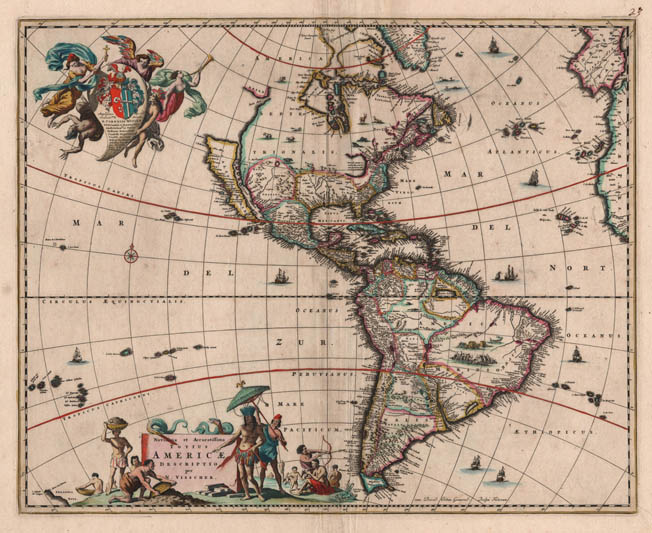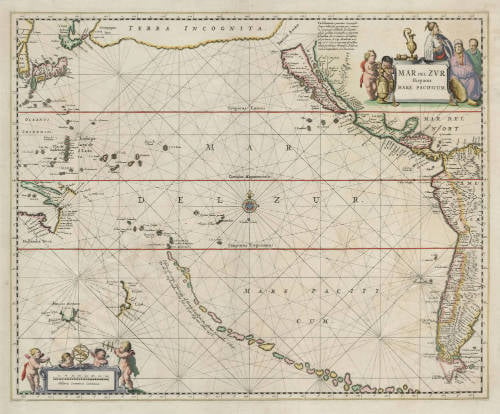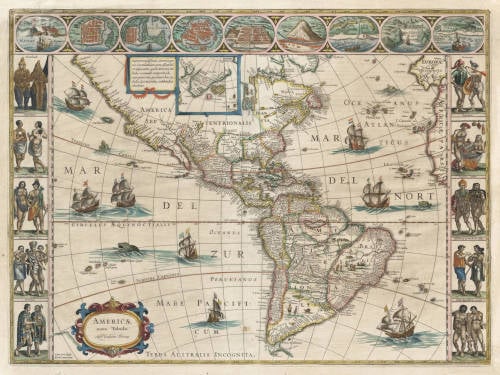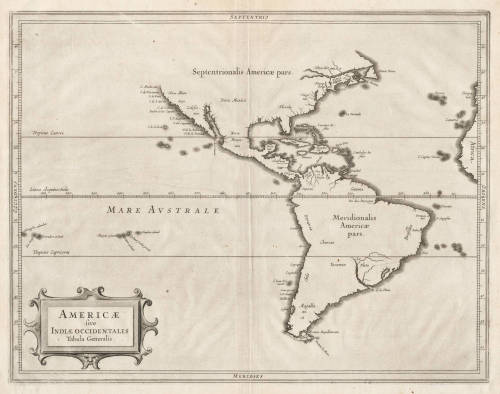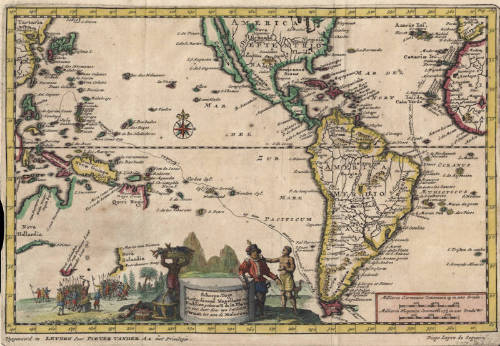Leen Helmink Antique Maps
Antique map of America by Visscher
The item below has been sold, but if you enter your email address we will notify you in case we have another example that is not yet listed or as soon as we receive another example.
Stock number: 18658
Zoom ImageCartographer(s)
Nicolaes Visscher I (biography)
Title
Totius Americae Descriptio
First Published
Amsterdam, 1658
This Edition
1677
Size
43.3 x 54.2 cms
Technique
Condition
excellent
Price
This Item is Sold
Description
Nicolaes Visser's legendary and important map of America, with California depicted as an island.
"Various dates have been attributed to this map from 1658 to 1680. The earliest date derives from its presence in the third volume of Joannes Janssonius' Novus Atlas, dated 1658. However, it is not present in all examples, and other maps in them have borne dates as late as the 1680s. The heirs of Joannes Janssonius, who died in 1664, appear to have issued the volumes with old title pages on a continuous basis. Therefore, no firm date can be derived from its use here. Upon the death of Nicolaas' father in 1652, the family were still using the old Pieter van den Keere continental plates of 1614. The sixth and last recorded state of these is, in fact, dated 1652. It would seem logical to assume that Visscher would feel the need for a new set of plates of the continents and world. The latter bears features in China introduced in 1655, so the set probably followed thereafter, with a date of c.1658 being quite probable.
Although the map did not provide much in the way of cartographic advances, it had a large influence. future cartographers drawing upon either its geography or the distinctive cartouches. One of its most recognisable features is the large open lake in the place of the western Great Lakes. The single lake to its east most probably represents that of Ontario, but is named Lac contenant. This, like much of the map, is derived from Joan Blaeu's wall map of the world, 1648. The use of Real de Nueva Mogui correctly placed on the east bank of the Rio del Norte is taken directly from Blaeu. One area where Visscher breaks away from this, is in his depiction of the west coast. He uses an older model still, that of Briggs, 1625, although with a broader north coast to California as an island, a feature that is not found in any earlier works. He continues the mainland coastline north-north-east towards the Strait of Anian, which separates it from ANIAN. The title is decorated with a scene showing the panning of gold or silver, with a native standing by under an umbrella. The cartouche top left bears a dedication to Cornelis Witsen, and depicts three angels helping a native Indian to heaven while the devil is falling away.
As stated the map has been found in various examples of Janssonius' Novus Atlas, and also in the Atlas Major issues. The map is found in Visscher’s undated Atlas Contractus, usually in its first state. In 1677 Visscher obtained a privilege which was added to the plate; two years later he died. His son, Nicolaas II, continued the business, issuing his own Atlas Minor in which it is found. It has been noted in atlases that can be dated to as late as c. 1696.
Visscher's privilege was renewed in 1697. In 1702 he died and the business was continued with some considerable vigour by his widow Elizabeth, who maintained the Atlas Minor. One atlas survives with the title of Atlas Major. With her death in 1726 the famous firm begun by Claes Jansz. Visscher sometime before 1608, passed out of the family and into the hands of Andries de Leth. Many of the plates were disposed of to Petrus Schenk II, at a date that is unknown, possibly before the death of Elizabeth, but after the death of Schenk's father c.1718/19. The map appears in examples of his Atlas Contractus, which is similarly undated and composite in nature, until c.1740. The map has also been located in examples of atlases by Frederick de Wit, the heirs of Janssonius, Abraham Wolfgang, Carol Allard and the Ottens family."
(Burden).
"California with nearly flat northern coast, much like the Briggs type. Straet Anian and ANIAN too far north. Partial coastline of Zelandia Nova (New Zealand) too far southwest. Dedicated to D. Cornelio Witsen, mayor of Amsterdam and one of the directors of the Dutch West India Company, whose arms are shown on a shield supported by angels (upper left). Title is on a stone block with two snakes above and figures of natives on either side. A chief is under an umbrella to right of title (lower left)."
(McLaughlin).
"A map of importance ... it became the standard representation of North America for a number of years, [that was] copied by other Dutch and English publishers."
(Tooley).
"The same map, and probably plate, was used by de Wit and others"
(Karpinsky).
"It was the first of a most popular series of maps of the Americas of the late seventeenth and early eighteenth centuries. With dubious guile, the publishers of succeeding issues of the map would rearrange the figures in the cartouches as well as the cartouches themselves, presumably to avert accusations of plagiarism. The map shows one of the Great Lakes as a large, square-shaped lake open at its western end. The island of California is delineated in the less common Briggs shape marked by the flattened northern coast."
(Martayan Lan).
Condition
This example in pristine collector's condition. Thick paper, with wide margins all around. No restorations or imperfections. Paper color off-white/ivory with no discoloration. In early hand color, applied by the Visscher publishing house at the time of production. An early strong and even impression of the copperplate, from the 1677 edition. Second state, with the privilige (copyright notice) granted by the Dutch States General.
Claes Janszoon Visscher 1587-1652
Nicolaes Visscher I (son) 1618-1679
Nicolaes Visscher II (grandson) 1649-1702
Elisabeth Visscher (widow of N. Visscher II)
"For nearly a century the members of the Visscher family were important art dealers and map publishers in Amsterdam. The founder of the business, Claes Janszoon Visscher, had premises near to those of Pieter van den Keere and Jodocus Hondius whose pupil he may have been.
From about 1620 he designed a number of individual maps, including one of the British Isles, but his first atlas consisted of maps printed from plates bought from van den Keere and issued as they stood with some additions of his own, including historical scenes of battles and sieges for which he had a high reputation.
Some maps bear the latinized form of the family name: Piscator. After Visscher's death his son and grandson, both of the same name, issued a considerable number of atlases, constantly revised and brought up to date but most of them lacking an index and with varying contents.
The widow of Nicholaes Visscher II carried on the business until it finally passed into the hands of Pieter Schenk."
(Moreland & Bannister).
Related Categories
Related Items
